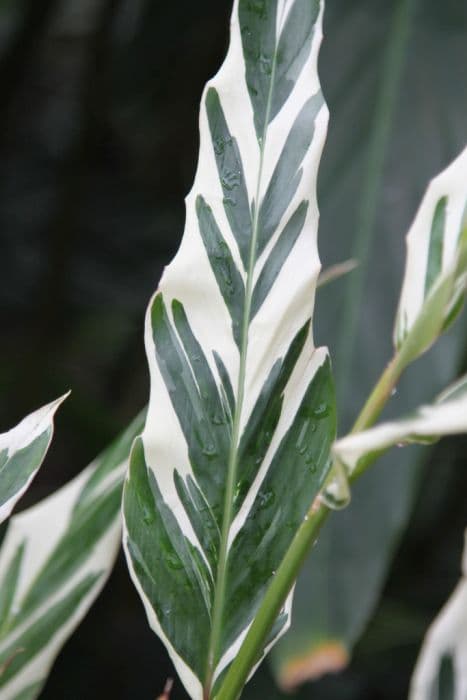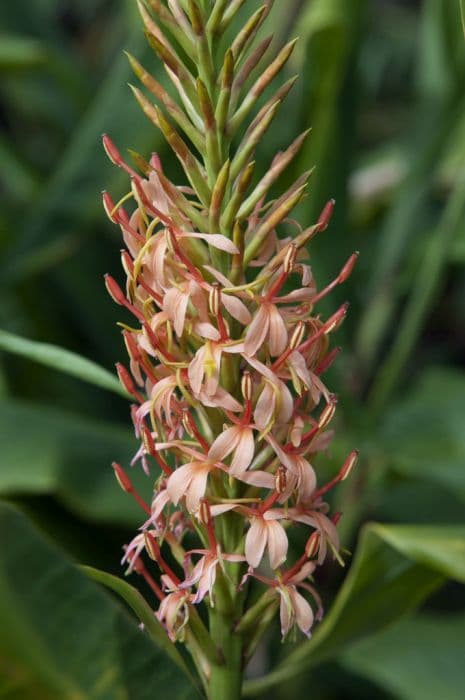Kahili Ginger Hedychium gardnerianum

ABOUT
Commonly known as Kahili ginger, this plant is characterized by its long, lance-shaped leaves that exude a lush, tropical green hue. The foliage is dense, providing a rich backdrop for its striking floral display. The flowers, which are the most distinctive feature of the Kahili ginger, emerge on long, erect spikes that stand out amidst the greenery. Each spike is adorned with clusters of bright yellow blossoms that possess a delicate, yet unmistakable fragrance. The blooms are often accentuated by showy red filaments that add a vibrant contrast to the cheerful yellow, making the flowers truly eye-catching. The overall presentation of the Kahili ginger is one that evokes the warmth and exoticism of a tropical paradise, making it a popular choice for gardens that aim to capture a sense of escape and natural beauty. Despite its alluring appearance, it’s important to note that in some regions this plant is considered invasive and its growth is controlled to protect local ecosystems.
About this plant
 Names
NamesFamily
Zingiberaceae
Synonyms
Kahili Ginger, Kahila Garland-lily, Ginger Lily
Common names
Hedychium gardnerianum
 Toxicity
ToxicityTo humans
The plant commonly known as Kahili ginger is not generally considered poisonous to humans. Ingesting parts of this plant typically does not lead to serious toxic symptoms. However, as with many plants, it is always advisable to avoid ingestion as there may be individual sensitivities or allergic reactions.
To pets
Kahili ginger is not specifically listed as toxic to pets. However, it is generally recommended to prevent pets from ingesting plants, as they can sometimes cause gastrointestinal upset or other mild symptoms due to the sensitivity of animals' digestive systems to various plant compounds. If a pet ingests Kahili ginger and shows signs of distress, it is wise to consult a veterinarian.
 Characteristics
CharacteristicsLife cycle
Perennials
Foliage type
Evergreen
Color of leaves
Green
Flower color
Yellow
Height
6 feet (1.8 meters)
Spread
3 feet (0.9 meters)
Plant type
Herb
Hardiness zones
8
Native area
Himalayas
Benefits
 General Benefits
General Benefits- Ornamental Value: Kahili ginger is known for its striking yellow flowers and lush green foliage, often used as a decorative element in gardens and landscapes.
- Low Maintenance: It is relatively easy to care for and does not require frequent watering or fertilization, making it a low-maintenance option for gardeners.
- Habitat for Wildlife: The flowers of Kahili ginger can attract pollinators such as bees, butterflies, and birds, providing them with nectar and supporting biodiversity.
- Erosion Control: The robust root system of Kahili ginger helps stabilize soil in garden settings, which can prevent erosion on slopes and banks.
- Shade Tolerance: This plant can flourish in partially shaded environments, making it suitable for underplanting in woodland gardens or shaded areas.
- Cultural Significance: Kahili ginger holds cultural importance in certain regions, often used in traditional lei-making and in other cultural practices.
- Privacy Screen: Due to its fast growth and dense foliage, Kahili ginger can be used to create a natural privacy screen in residential gardens or public spaces.
 Medical Properties
Medical Properties- Antimicrobial: Some studies suggest that Hedychium gardnerianum possesses antimicrobial properties, which could be useful in the treatment of bacterial or fungal infections.
- Anti-inflammatory: There is evidence to indicate that extracts from the plant may exhibit anti-inflammatory effects, potentially applicable to conditions involving inflammation.
- Analgesic: The plant has been reported to have pain-relieving properties which could be harnessed to alleviate different types of pain.
 Air-purifying Qualities
Air-purifying QualitiesThis plant is not specifically known for air purifying qualities.
 Other Uses
Other Uses- Hedychium gardnerianum, also known as kahili ginger, is used in the horticulture industry as a striking ornamental plant due to its large, showy flowers and pleasant fragrance.
- The fibrous stems of kahili ginger can be used in the production of small-scale, handcrafted paper or as a natural fabric for artistic purposes.
- Due to its robust nature and rapid growth, kahili ginger can be used in erosion control and soil stabilization in areas where other plants might not thrive.
- The dense thickets of kahili ginger provide habitats for small animals and insects, albeit it is often considered invasive outside of its native range.
- Kahili ginger can be processed into an aromatic essential oil that is used in perfumery and aromatherapy for its exotic scent.
- Enthusiasts of natural dyes may use kahili ginger as a source of dye for textiles, although this is not a common application.
- The plant is sometimes used in floral arrangements and lei making in Hawaii, although it is not native to those islands and is considered invasive.
- Because of its large showy blooms, kahili ginger is occasionally used as a natural backdrop or set decoration for outdoor events or in the film industry.
- The rhizomes might be used as a source of food for pigs and other animals in subsistence farming, especially where the plant grows in abundance and other feed is limited.
- In traditional crafts, the leaves of kahili ginger can be used in weaving to create mats and baskets, when other more preferred materials are not available.
Interesting Facts
 Feng Shui
Feng ShuiThe Kahili ginger is not used in Feng Shui practice.
 Zodiac Sign Compitability
Zodiac Sign CompitabilityThe Kahili ginger is not used in astrology practice.
 Plant Symbolism
Plant Symbolism- Invasive Nature: Kahili ginger, as Hedychium gardnerianum is commonly known, is often associated with invasiveness due to its ability to spread quickly and dominate landscapes, symbolizing situations or traits that can get out of control if not managed properly.
- Exotic Beauty: The striking appearance of kahili ginger's flowers can represent exotic beauty and allure, evoking a sense of wonder and appreciation for the unique and visually stunning.
- Healing Properties: In some cultures, kahili ginger is recognized for its medicinal benefits, symbolizing healing and therapeutic qualities.
- Connection to the Tropics: Kahili ginger's tropical origins could symbolize a connection to these regions, representing exoticness, warmth, and lush environments.
 Water
WaterThe Kahili ginger should be watered deeply and the soil allowed to partially dry between waterings. In general, watering every 5 to 7 days during the active growing season is adequate, with a significant reduction in watering frequency during the dormant winter period. As a guideline, you might use about 1 gallon of water for a medium-sized plant each time you water. Ensure that the plant is in well-draining soil to avoid waterlogging, which can lead to root rot. It's also important to water directly at the base to avoid wetting the foliage which could lead to fungal diseases.
 Light
LightKahili ginger thrives in partial shade where it receives filtered sunlight, avoiding the intense direct sun of midday. An ideal spot for the Kahili ginger is one where it gets bright, indirect light, such as under the canopy of tall trees. If grown indoors, placing it near a north or east-facing window can provide optimal light conditions.
 Temperature
TemperatureKahili ginger prefers a warm climate and does well in temperatures ranging from 50°F to 85°F. The minimum temperature should not fall below 50°F, as it can cause damage to the plant, while too much heat when temperatures rise consistently above 85°F might stress the plant. The ideal temperature for the Kahili ginger is between 65°F and 75°F for robust growth.
 Pruning
PruningPruning Kahili ginger is mostly done to remove dead or yellowing leaves and spent flower stalks to encourage healthy growth and appearance. The best time to prune is after flowering, usually in late summer or early fall. You can also cut back the foliage to the ground in late winter or early spring before the new growth begins. Pruning once a year is typically sufficient unless there's damage or disease that requires immediate attention.
 Cleaning
CleaningAs needed
 Soil
SoilKahili ginger prefers a rich, loamy soil that is well-draining with a pH of 6.0 to 6.8. Ideal soil mix could be one part garden soil, one part compost, and one part perlite or coarse sand to ensure proper drainage and aeration. Consistency in moisture is crucial, but avoid waterlogging.
 Repotting
RepottingKahili ginger should be repotted every 2-3 years or when it becomes root-bound. The plant's vigorous growth may require division at the time of repotting to manage its size and encourage rejuvenation.
 Humidity & Misting
Humidity & MistingKahili ginger thrives in high humidity conditions, ideally between 60-80%. If grown indoors, humidity levels can often be increased with the use of humidifiers or placing the plant on a tray of moistened pebbles.
 Suitable locations
Suitable locationsIndoor
Place Kahili ginger in bright, indirect light indoors and ensure high humidity.
Outdoor
Grow Kahili ginger in partial shade with rich soil and consistent moisture.
Hardiness zone
8-11 USDA
 Life cycle
Life cycleKahili ginger begins its life cycle as a rhizome, a type of underground stem that stores energy for the plant. As temperatures rise in the spring, the rhizome sends up shoots, which will develop into tall, leafy stalks. These stalks can reach up to 2 meters in height and bear the characteristic, fragrant yellow flowers with red stamens in the summer and fall. After pollination, which is often facilitated by insects, the flowers will produce seed capsules containing numerous seeds that can be dispersed by animals, water, or humans. As the cooler weather arrives, the above-ground parts of the plant die back, while the rhizome survives underground, going dormant through the winter months. In suitable conditions, the cycle repeats as the rhizome generates new growth the following spring.
 Propogation
PropogationPropogation time
Spring to Summer
The Kahili Ginger, or Hedychium gardnerianum, is typically propagated by dividing the rhizomes. This process is best done in the spring or early summer when the plant's growth is most vigorous. To propagate by division, gardeners should carefully dig up the rhizomes and shake off the excess soil. Using a sharp, clean knife, the rhizomes are then cut into sections, ensuring that each section has at least one growth bud. The cuttings are then allowed to dry for a few hours to form a callus over the cut surfaces, helping to prevent rot. Once prepared, these divisions are planted in well-draining soil at a depth of about 2 inches (5 centimeters), and they should be spaced at least 12 inches (30 centimeters) apart to allow space for growth. Regular watering and a location with partial to full sun will encourage the new divisions to establish and grow into robust plants.









